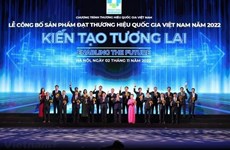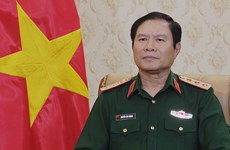Dien Bien Phu victory – a golden page in Vietnam’s history
The Dien Bien Phu Victory became a pride of Vietnamese people and a symbol of
national strength.
The Dien Bien Phu Victory on May 7, 1954, which ended French colonial
rule in Vietnam, became a pride of Vietnamese people and a symbol of
national strength.
In 1947, one year after the launch of the Nationwide Resistance War by President Ho Chi Minh, the French colonialists became aware of the special importance of the region north of Hanoi – the nerve-centre of the resistance war.
General Henri Navarre, Commander-in-Chief of the French forces in Indochina, decided to focus the defence of Vietnam’s northwestern region, then controlled by the French, on the Dien Bien Phu air-infantry base and guard it at any cost.
Dien Bien Phu was a complex of strong fortresses with 16,200 French troops, the most seasoned in Indochina, stationed in 14 fortifications of three sub-divisions. After a fact-finding tour of Dien Bien Phu , US General John O’Daniel concluded that it is an unshakeable stronghold.
The Party Committee of the Vietnamese army held that only when the Dien Bien Phu fortifications are crushed will Navarre’s military scheme fall apart.
A conference on the combat plans was organised by the Command of the Dien Bien Phu Campaign right on the battlefield. General Vo Nguyen Giap, Commander-in-Chief of the Vietnamese People’s Army and Commander of the Campaign, presented the plans and entrusted tasks to officers.
At 5:00 pm on March 13, 1954, the Vietnamese army fired the first shots to kick off the Dien Bien Phu Campaign.
In an attack on Him Lam (Beatrice) fortifications during the first minutes of the battle, Vietnam ’s artillery killed the stronghold’s commander Paul Pegot and Jules Gaucher, commander of the central division.
On the first day of the campaign, the Vietnamese army annihilated 300 enemy troops and captured 200 others.
From March 14-17, it wiped out the two most fortified camps of the enemy and disintegrated a French battalion. The French troops in Ban Keo raised a white flag to surrender. The northern gate of the centre of the Dien Bien Phu fortresses was wide open.
In the midst of victory, the Vietnamese army continued to launch the second attack on the enemy’s five eastern key defence heights. They fought days and nights, pushing the enemy into a difficult situation.
This time, in a base north of Hanoi , under the chair of President Ho Chi Minh, the Central Party Committee and Government convened and passed a resolution on mobilising all resources for the Dien Bien Phu Campaign for the ultimate victory.
The Vietnamese army’s assaults forced French and US representatives to sit at a roundtable meeting in Geneva, Switzerland with delegations from China , Russia and Vietnam to restore peace in Indochina .
At 3:00 pm on May 7, 1954, the Vietnamese army launched a massive attack on the headquarters of General Christian De Castries. The French commander at Dien Bien Phu was captured. The “Quyet chien, quyet thang” (Determined to fight and to win) flag handed over by President Ho Chi Minh proudly flew above the De Castries’ bunker. The Dien Bien Phu Campaign came to a complete victory.
The victory was a vivid manifestation of the huge development of the Vietnamese army. The ten-year-old force, led by General Vo Nguyen Giap, achieved greatness and forged an everlasting reminder of Vietnamese strength, intelligence and unbending will.-VNA
In 1947, one year after the launch of the Nationwide Resistance War by President Ho Chi Minh, the French colonialists became aware of the special importance of the region north of Hanoi – the nerve-centre of the resistance war.
General Henri Navarre, Commander-in-Chief of the French forces in Indochina, decided to focus the defence of Vietnam’s northwestern region, then controlled by the French, on the Dien Bien Phu air-infantry base and guard it at any cost.
Dien Bien Phu was a complex of strong fortresses with 16,200 French troops, the most seasoned in Indochina, stationed in 14 fortifications of three sub-divisions. After a fact-finding tour of Dien Bien Phu , US General John O’Daniel concluded that it is an unshakeable stronghold.
The Party Committee of the Vietnamese army held that only when the Dien Bien Phu fortifications are crushed will Navarre’s military scheme fall apart.
A conference on the combat plans was organised by the Command of the Dien Bien Phu Campaign right on the battlefield. General Vo Nguyen Giap, Commander-in-Chief of the Vietnamese People’s Army and Commander of the Campaign, presented the plans and entrusted tasks to officers.
At 5:00 pm on March 13, 1954, the Vietnamese army fired the first shots to kick off the Dien Bien Phu Campaign.
In an attack on Him Lam (Beatrice) fortifications during the first minutes of the battle, Vietnam ’s artillery killed the stronghold’s commander Paul Pegot and Jules Gaucher, commander of the central division.
On the first day of the campaign, the Vietnamese army annihilated 300 enemy troops and captured 200 others.
From March 14-17, it wiped out the two most fortified camps of the enemy and disintegrated a French battalion. The French troops in Ban Keo raised a white flag to surrender. The northern gate of the centre of the Dien Bien Phu fortresses was wide open.
In the midst of victory, the Vietnamese army continued to launch the second attack on the enemy’s five eastern key defence heights. They fought days and nights, pushing the enemy into a difficult situation.
This time, in a base north of Hanoi , under the chair of President Ho Chi Minh, the Central Party Committee and Government convened and passed a resolution on mobilising all resources for the Dien Bien Phu Campaign for the ultimate victory.
The Vietnamese army’s assaults forced French and US representatives to sit at a roundtable meeting in Geneva, Switzerland with delegations from China , Russia and Vietnam to restore peace in Indochina .
At 3:00 pm on May 7, 1954, the Vietnamese army launched a massive attack on the headquarters of General Christian De Castries. The French commander at Dien Bien Phu was captured. The “Quyet chien, quyet thang” (Determined to fight and to win) flag handed over by President Ho Chi Minh proudly flew above the De Castries’ bunker. The Dien Bien Phu Campaign came to a complete victory.
The victory was a vivid manifestation of the huge development of the Vietnamese army. The ten-year-old force, led by General Vo Nguyen Giap, achieved greatness and forged an everlasting reminder of Vietnamese strength, intelligence and unbending will.-VNA













